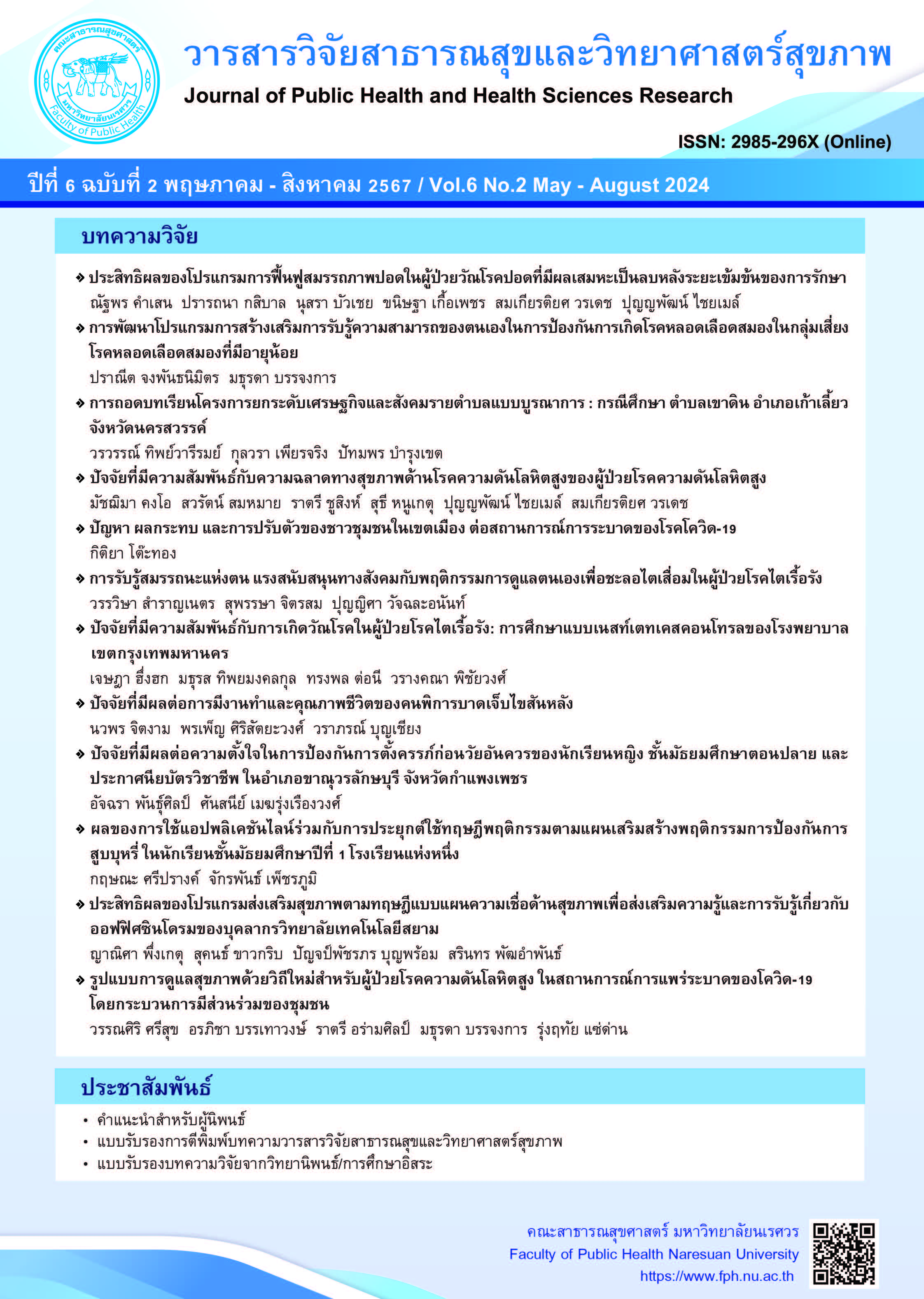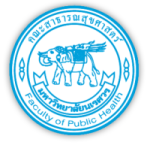Effectiveness of health promotion program based on the health belief model for promoting knowledge and perception about office syndrome of Siam Technology College personnel
Keywords:
Knowledge, Perception, Health promotion program, Office syndromeAbstract
This study aimed to study the effects of a health promotion program based on the health belief model for promoting knowledge and perception about office syndrome of Siam technology college personnel. The sample were 115 people of Siam Technology College. The research instruments consisted of 1) the health promotion program based on the health belief model for promoting knowledge and perception about office syndrome and 2) knowledge and perception about office syndrome questionnaire. The data were analyzed using descriptive statistics such as means, frequency, standard deviation, and inference statistics, including t-test at the statistical significance level of 0.05.
The results were as follows; 1) The health promotion program based on the health belief model was effectively to increase knowledge and perception about office syndromeof Siam Technology College personnel. 2) The mean score of knowledge about office syndrome after receiving the health promotion program was significantly higher than before at 0.05 level. 3) The mean score of perceived susceptibility of office syndrome, perceived severity of office syndrome, perceived benefits of office syndrome and perceived barriers of office syndrome after receiving the health promotion program was significantly higher than before at 0.05 level. Therefore, it is essential to organize activities to promote knowledge and perception about office syndrome for person in the organization to increase the level of knowledge and perception, regarding in protect and health care behavior of office syndrome.
References
Becker, M. H., Drachman, R. H., & Kirscht, J. P. (1974). A new approach to explaining sick-role behavior in low-income populations. American Journal of Public Health, 64(3), 205-216.
Becker, M. H., & Maiman, L. A. (1975). Sociobehavioral determinants of compliance with health and medical care recommendations. Medical care, 13(1), 10-24.
Bloom, B.S. (1964). Taxonomy of education objective: The classification of educational goals: Handbook II: Affective domain. New York: David Mckay.
Bureau of Occupational and Environmental Diseases. (2018, July 20). The Department of Disease Control invites office workers to adjust 3 P. to reduce pain and reduce the risk of office syndrome. Retrieved October 17, 2022, from https://pr.moph.go.th/?url=pr/detail/2/02/113832/
Krejcie, R. V. & Morgan, D. W. (1970). Determining sample size for research activities. Educational and Psychological Measurement, 30(3), 607-610
Department of Disease Control. (2018). The Department of Disease Control invites office workers to adjust 3 P. to reduce pain and reduce the risk of office syndrome. Retrieved October 17, 2022, from https://pr.moph.go.th/?url=pr/detail/2/02/113832/.
Department of Health. (2019). Guidelines for promoting health and environmental hygiene in the workplace package 6 Conquering Office Syndrome Office Syndrome Management. (1st ed). Nonthaburi: MD All Graphic Company Limited.
Klaeokla, S. (2018). Risk management from routine work in office syndrome with physical activities (Individual Study). Bangkok Institute of Civil Service Development. (in Thai)
Photihung, P., Damnong, N., & Tassanatanachai, A. (2021). Relationship between health literacy related to office syndromes and office syndrome prevention behavior among supportive personnel at a university. Thai Red Cross Nursing Journal, 14(2), 235-250. (in Thai)
Phajan, T & Sooksalung, P. (2020). Prevalence and factors associated with low back pain among health personnel in Khon Kaen Provincial Health Office. Academic Journal of Community Public Health, 6(3), 196-205. (in Thai)
Rosenstock M. (1974). Historical origins of the health belief model. Health Education, Monographs, 2, 328-335.
Rosenstock, l. M. (1996). Why people use health services. The Milbank Memorial Fund Quarterly, 44, 94-127.
Saetiaw, S., Thongmeekhaun, T., & Juntaveemuang, V. (2019). Effects of an education-based program on hazard perception and preventive behaviors of computer syndrome among working computer users: Public offices in Songkhla Town’s area. Nursing Journal of the Ministry of Public Health, 29(1), 48-59. (in Thai)
Saewong, S., Srikhruedong, S., & Thitishotirattana, W. (2022). The health promotion program base on Buddhist psychology for relieve office syndrome of information technology personnel. Journal of MCU Humanities Review, 8(2), 17-35. (in Thai)
Sunanta, R., Chantaramanee, N., & Srisookkum, T. (2022). Predictive factors affecting computer worked-related musculoskeletal aches of personnel University of Phayao. The Office of Disease Prevention and Control 10th Journal, 20(2), 56-72. (in Thai)
Thai Health. (2022). The meaning of health promotion innovation. Retrieved October 17, 2022, from https://www.thaihealth.or.th/?p=166968 (in Thai)
Thongmeekhaun, S., Sungkhachat, B., Kitrungroap, T., Wattanasart, T., Juntaveemuang, V. & Meena, S. (2018). Computer related health problems: Risk perception in protection behaviors among supporting staffs. The Southern College Network Journal of Nursing and Public Health, 5(2), 258-271. (in Thai)
Downloads
Published
How to Cite
Issue
Section
License
Copyright (c) 2024 Journal of Public Health and Health Sciences Research

This work is licensed under a Creative Commons Attribution-NonCommercial-NoDerivatives 4.0 International License.
The published article is copyrighted by the Journal of Public Health and Health Sciences Research.
The statements that appear in each article in this academic and research journal are the personal opinions of each author and are not related to Naresuan University and other faculty members in the university. Responsibilities regarding each article are the responsibility of each author.






